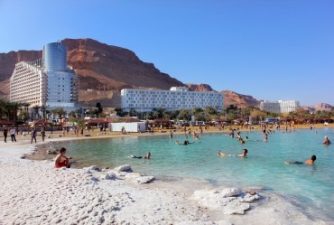Could the ocean make pumped hydro power? In the Middle East, it could.
A brilliant proposal has been made to build a massive 2,400 MW sea water hydro project using the Mediterranean Sea, and the Dead Sea, which is below sea level. The Dead Sea Power Project would use the ocean to make hydro power, in a world first.
The ambition and scope of the project would be on a scale almost like terraforming Mars – and the environment is not much more hospitable.
Sea water has never been used in pumped hydro power, because sea water is all level at sea level, and hydro power requires higher reservoirs to work. Here’s how this completely new way to make hydro power using an ocean would work.
Normally hydro power is created by simple gravity as rushing water falls down from higher ground.
The idea behind normal hydro power storage is that it uses excess electricity to provide the off-peak power to pump water back up a hill into a vast reservoir. Then, when it is needed, it is released to rush down through turbines below, churning out electricity. Normally that electricity is provided by excess unwanted wind power at night and utilizes a reservoir at the top to hold the water (potential energy) till needed.
How this project would work:
A tunnel below sea level from the Mediterranean Sea would funnel sea water through a 10 meter diameter (30 foot) wide concrete tunnel 72 km ( 45 miles) to a very deep indentation in the rocky landscape about half way across land towards the Dead Sea. No energy would be needed to move the Mediterranean water to the inland sea water reservoir, because the water does not need to go uphill the whole distance.
Then, when needed during peak electrical demand; water would be released down to power turbines 423 meters below sea level on the shores of the Dead Sea which is 1,387 feet below sea level – generating up to 2,400 MW as needed.
The fresh Mediterranean Sea water spilling out on top of the Dead Sea would replenish and revitalize it with much less salty water, which would tend to float on top, while generating substantial power. The Dead Sea has been shrinking, and needs more water. Saving the Dead Sea would have tourism benefits. (Time Running Out for Saving Dead Sea Hotels)
The project would help ease power and water shortages in the region as hydro power could be used to power desalination.
It would have geo-political benefits as well. Crossing the borders of three entities, Jordan, the Palestinian Authority and Israel – this project leverages shared regional needs to provide a platform for shared problem solving.
All three areas would have access to this Mediterranean water for desalination plants to help ease the chronic water shortages, and the electric power would be sold into the existing electrical grids of all three regions to pay the cost of the Project.
Related stories:
New Life Found In Dead Sea! (Amazing Photos)
Dead Sea Inspires Advantix Systems’ Cooling Tech





The project is very good thinking.Still we should study following to implement it.
1. Dead sea has no direct connection with open sea, it means the water in it is gained from under ground or side walls from the rocks, sands, soils, rain etc.This water is then dried by atmospheric heat.So when water is delivered in dead sea the water will not mix with ocean to make its level.The input ratio of water will be more than output so the level of water will be more and more daily and make disturbances in the project concept.
I think this is a good project because one of the benefits would be to use the electricity for desalination. This would help ease the freshwater crisis in the Middle East. If it is done then perhaps Egypt would learn from this and go through with the Qattara Depression project which is similar but on a much larger scale.
The basic reason this project is being considered is because the human population keeps growing and needing more electricity. So, how many people can that geographical area support? It seems almost no one is willing to examine and answer that question, and when the life-supporting environment breaks down under the growing mass of pollution it will be too late.
To save the dead sea, we could stop the crazy pumping and diverting of the Jordan river no ?
I think that the Jordan water is needed elsewhere and that is only one of the problems.
This is the report of the mixing study conducted by the World Bank
http://siteresources.worldbank.org/INTREDSEADEADSEA/Resources/Tahal_Initial_Final_Report_August_2011.pdf
Paul, that is an interesting take.
Thanks, Randolph, yes, I thought the previous projects also were Red-Dead, which is much more risky. I seem to remember one, that would lead to the inadvertent manufacture of Gypsum-like water in the Dead sea – is that right?
No geo-engineering project is without risk, but reduced inflows of fresh water due to population growth has probably already had a greater impact on Dead Sea ecology than we know. Invasive species could become a problem, but perhaps UV and ozone, etc. could be used to sterilize the incoming flow. I also wonder if a gravity fed reverse osmosis system could produce some fresh water for the region, or in a wave powered hydroelectric storage system? Added value for easier approval?
should have read “Yes, there have been many plans for connecting the Dead Sea with either The Med or the Red.”
Yes, there have been many plans for connecting the Dead Sea with either the Med or the Dead. Our plan is unique in its capacity, enabled by the fact that the Dead Sea is presently at the level 428mbsl, and will be around 435mbsl by the time a project can become operative. This fill volume, including evaporation and desalination, will enable the payment for the project, tunnel and hydro plant, by the time the Dead Sea would be filled to 1970’s level.
Our tunnel design is different from the 80s design in that it is much larger tunnel, and below sea level, below both the upper and lower aquifer in Israel. Also the tunnel is planned to be lined to prevent inflow of water from outside the tunnel. The danger is inflow into the tunnel, not leakage from sea water to outside, because the water pressure outside the tunnel is greater than the zero pressure inside produced by gravity flow.
Please take a look at frequently asked questions on the website.
Thanks, Maurice, Xoussef and Karin. I bow to your greater relevant local expertise.
This kind of plan will be (has been) shot down by environmentalists for the same reasons as the Red Sea Dead Sea canal. There are too many unknowns.
As you have pointed out on some occasions here on Green Prophet, the Dead sea, isn’t dead. An influx of Med water would bring salts that are very different to those in the dead sea, potentially altering its chemical composition, and could contaminate it with new life forms before we get to know the unique critters that live in its bottom very well. Also, I don’t think boring a 76 km long tunnel will not damage water tables, and what of a leak?
In short it’s a very tempting idea, but not necessarily a good one. I hope there are people somewhere studying it thoroughly.
This is definitely not a “first” for the channeling of sea water to the Dead Sea to create electricity. A similar project, termed the “Med – Dead Canal” was proposed in Israel during the 1980’s which would have relied a lot on “gravity flow” to bring the water from the Mediterranean to the Dead Sea, which is 420 meters below sea level.
The project was later scrapped due to the high costs involved.